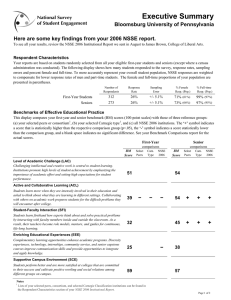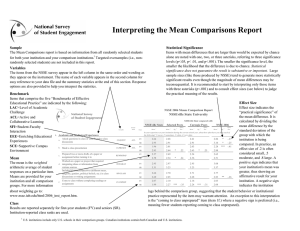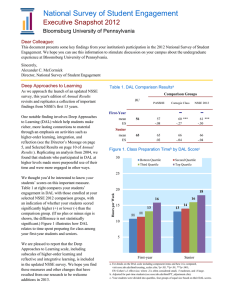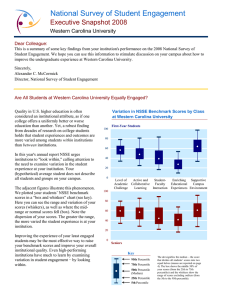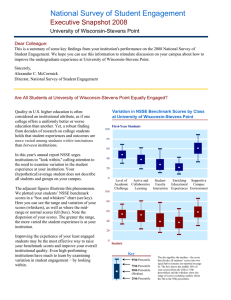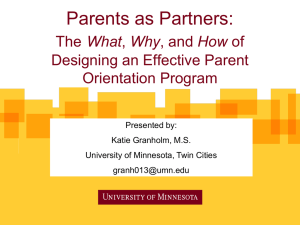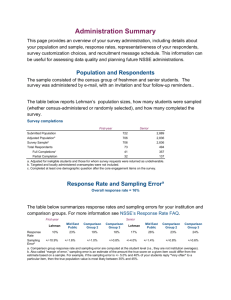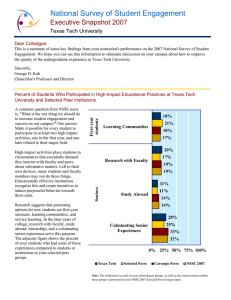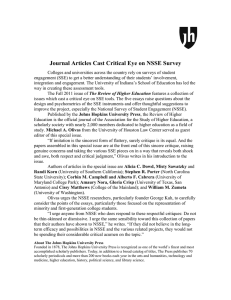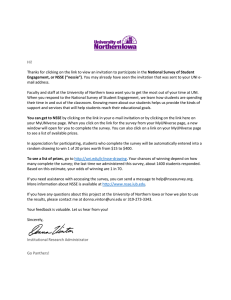National Survey of Student Engagement Executive Snapshot 2011 Bloomsburg University of Pennsylvania
advertisement
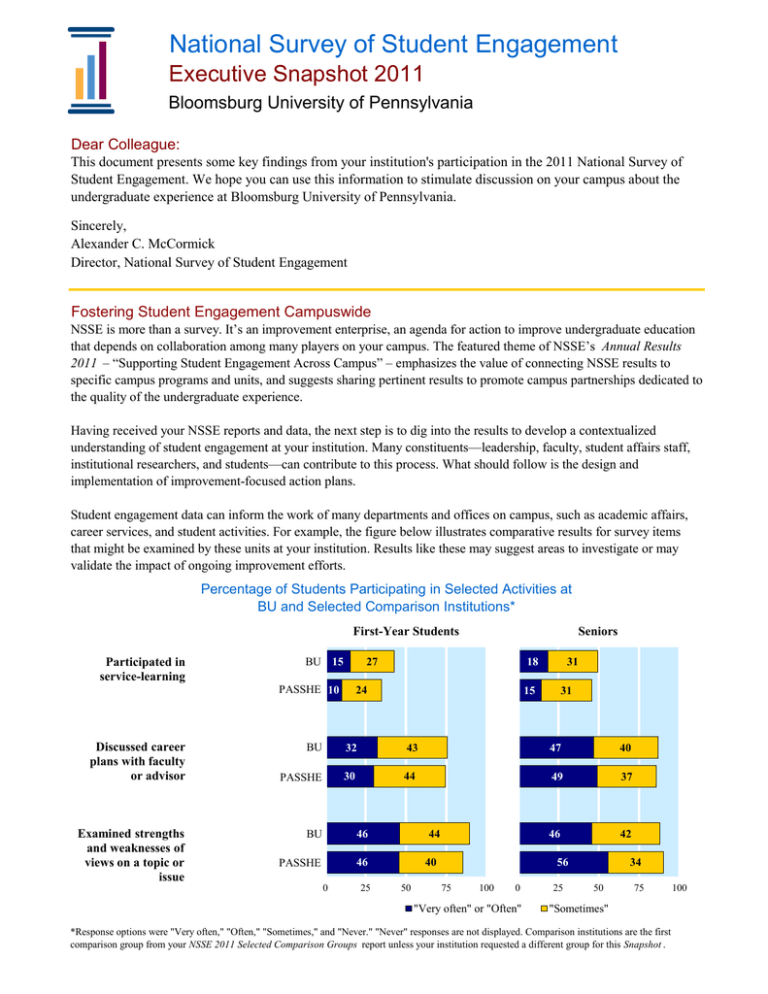
National Survey of Student Engagement Executive Snapshot 2011 Bloomsburg University of Pennsylvania Dear Colleague: This document presents some key findings from your institution's participation in the 2011 National Survey of Student Engagement. We hope you can use this information to stimulate discussion on your campus about the undergraduate experience at Bloomsburg University of Pennsylvania. Sincerely, Alexander C. McCormick Director, National Survey of Student Engagement Fostering Student Engagement Campuswide NSSE is more than a survey. It’s an improvement enterprise, an agenda for action to improve undergraduate education that depends on collaboration among many players on your campus. The featured theme of NSSE’s Annual Results 2011 – “Supporting Student Engagement Across Campus” – emphasizes the value of connecting NSSE results to specific campus programs and units, and suggests sharing pertinent results to promote campus partnerships dedicated to the quality of the undergraduate experience. Having received your NSSE reports and data, the next step is to dig into the results to develop a contextualized understanding of student engagement at your institution. Many constituents—leadership, faculty, student affairs staff, institutional researchers, and students—can contribute to this process. What should follow is the design and implementation of improvement-focused action plans. Student engagement data can inform the work of many departments and offices on campus, such as academic affairs, career services, and student activities. For example, the figure below illustrates comparative results for survey items that might be examined by these units at your institution. Results like these may suggest areas to investigate or may validate the impact of ongoing improvement efforts. Percentage of Students Participating in Selected Activities at BU and Selected Comparison Institutions* First-Year Students Participated in service-learning Discussed career plans with faculty or advisor Examined strengths and weaknesses of views on a topic or issue BU 15 Seniors 27 18 31 "Very often" "Sometimes" or "Often" PASSHE 10 24 15 27 10 24 BU 32 4332 43 PASSHE 30 44 30 44 46 44 BU 46 PASSHE 46 0 25 46 "Very often" "Sometimes" or "Often" 15 31 47 40 40 49 49 37 37 46 46 40 50 31 15 47 40 44 31 18 42 56 34 42 56 75 100 0 "Very often" or "Often" 25 34 50 75 "Sometimes" *Response options were "Very often," "Often," "Sometimes," and "Never." "Never" responses are not displayed. Comparison institutions are the first comparison group from your NSSE 2011 Selected Comparison Groups report unless your institution requested a different group for this Snapshot . 100 National Survey of Student Engagement Executive Snapshot 2011 (Bloomsburg University of Pennsylvania) NSSE 2011 Question Comparisons By examining individual NSSE questions, you can better understand what contributes to your institution's overall benchmark scores. This section features the five questions on which your first-year and senior students scored the highest and the five questions on which they scored the lowest, relative to students at the indicated comparison group (the group's members are listed in your NSSE 2011 Selected Comparison Groups report). While we chose these questions to represent the largest differences (in percentage points), they may not be the most important to your institutional mission or current program or policy goals. We encourage you to review your NSSE Institutional Report 2011 for additional results of particular interest to your campus. Highest Performing Benchmark Items Relative to PASSHE Comparison Groups Ques- Benchtion mark 1 Percentage of students who... First-Year Students 1h. ACL Worked with classmates outside of class to prepare class assignments2 BU PASSHE Carnegie Class NSSE 2011 45% 38% 44% 45% 7b. EEE Participated in community service or volunteer work 37% 31% 36% 39% 7c. EEE Participated in a learning community 22% 12% 16% 18% 62% 55% 60% 60% 56% 48% 51% 51% 82% 75% 81% 82% 70% 61% 60% 60% 67% 61% 61% 60% 64% 59% 56% 60% 59% 50% 57% 57% 10c. 10e. EEE Said the institution substantially encourages contacts among diverse peers SCE 4 Seniors 10a. LAC Said the institution provides substantial support for students' social needs Said the institution emphasizes studying and academic work4 1h. ACL Worked with classmates outside of class to prepare class assignments 1n. SFI Discussed grades or assignments with an instructor2 7b. EEE Participated in community service or volunteer work 8c. 4 SCE Positively rated their relationships with admin. personnel and offices 2 3 The adjacent figure, based on the table above, displays the questions on which your students compared most favorably with those in your selected comparison group named: PASSHE Percentage Point Difference First-Year Students Seniors 40 30 20 10 7 7 1h. 7b. 9 7 8 7 10c. 10e. 10a. 9 5 5 1n. 7b. 9 0 -10 7c. 2 1h. 8c. Lowest Performing Benchmark Items Relative to PASSHE Comparison Groups Ques- Benchtion mark 1 Percentage of students who... First-Year Students Wrote at least one paper or report of 20 pages or more 3c. LAC BU PASSHE Carnegie Class NSSE 2011 12% 17% 18% 18% 3d. LAC Wrote more than 4 papers or reports between 5 and 19 pages 20% 24% 29% 29% 3e. LAC Wrote more than 10 papers or reports of fewer than 5 pages 15% 27% 29% 28% 53% 58% 62% 60% 51% 55% 60% 58% 1a. 1q. ACL SFI Asked questions/contributed to class discussions 2 Received prompt written or oral feedback from faculty 2 Seniors 3c. LAC Wrote at least one paper or report of 20 pages or more 45% 49% 50% 49% 3e. LAC Wrote more than 10 papers or reports of fewer than 5 pages 26% 35% 31% 32% 1g. ACL Worked with other students on projects during class2 47% 53% 53% 49% 58% 64% 65% 66% 24% 30% 30% 28% 1t. 10d. ACL SCE Discussed ideas from readings or classes with others outside of class 2 Said the institution substantially helps students cope w/ non-acad. matters 4 The adjacent figure, based on the table above, displays the questions on which your students compared least favorably with those in your selected comparison group named: PASSHE Percentage Point Difference First-Year Students Seniors 10 0 -10 -4 -5 -5 -4 1a. 1q. -4 -9 -12 -6 -5 -6 1g. 1t. 10d. -20 -30 -40 3c. 3d. 3e. 3c. 3e. Notes LAC=Level of Academic Challenge; ACL=Active and Collaborative Learning; SFI=Student-Faculty Interaction; EEE=Enriching Educational Experiences; SCE=Supportive Campus Environment 2 Combination of students responding "Very often" or "Often" 3 Rated at least 5 on a 7-point scale 4 Combination of students responding "Very much" or "Quite a bit" 1 Respondent Characteristics The adjacent table displays your number of respondents, response rate, and sampling error by class. Sampling error is an estimate of the margin by which the true percentage of your students may differ from the reported percentage on a given item (because not all of your students completed surveys). 3 N Resp. Rate Sampling Error First-Year Students 434 19% +/-4.2% Seniors 556 29% +/-3.5% National Survey of Student Engagement Executive Snapshot 2011 (Bloomsburg University of Pennsylvania) Benchmarks of Effective Educational Practice To represent the multi-dimensional nature of student engagement, NSSE developed five indicators of effective educational practice. These "benchmarks" are created from clusters of NSSE questions that best represent these practices. The table below summarizes key benchmark results for your institution and institutions in your selected comparison groups. A '+' symbol indicates that your institution's score is higher than than the comparison group and a '-' symbol indicates a lower score (p <.05). A blank space indicates no significant difference. For additional details, review your NSSE 2011 Benchmark Comparisons report. Comparison Groups BU Class PASSHE Carnegie Class NSSE 2011 − − Level of Academic Challenge (LAC) How challenging is your institution's intellectual and creative work? First-Year 51 Senior 56 − − First-Year 41 − Senior 53 − + First-Year 34 Senior 44 + + Active and Collaborative Learning (ACL) Are your students actively involved in their learning, individually and working with others? Student-Faculty Interaction (SFI) Do your students work with faculty members inside and outside the classroom? Enriching Educational Experiences (EEE) Do your students take advantage of complementary First-Year learning opportunities? Senior 26 38 − − Supportive Campus Environment (SCE) Do your students feel the institution is committed to First-Year their success? Senior 62 58 IPEDS:211158 For More Information A comprehensive summary of all results is contained in your institutional report, which we sent in August to Sheila Jones, Office of Planning and Assessment. Reports used in this Executive Snapshot included the: NSSE 2011 Mean Comparisons, Frequency Distributions, Benchmark Comparisons, and Respondent Characteristics. National Survey of Student Engagement Indiana University Center for Postsecondary Research 1900 East Tenth Street, Suite 419 Bloomington, IN 47406-7512 4 Phone: 812-856-5824 E-mail: nsse@indiana.edu Web: nsse.iub.edu
